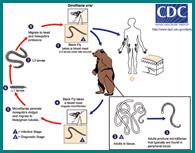| Bear
Filarial Worm |
 |
|
| |
| Causative Agent |
-
Parasitic disease of bears (Ursidae) caused by infection with the long,
hair-like
nematode or
filarial worm, Dirofilaria ursi.
|
| Images |
|
Click on
image to enlarge. |
 |
|
| Distribution |
|
Geographic: |
-
Bear
filarial worms have been reported in black bears (Ursus
americanus) in both Canada and the United States.
|
|
Seasonality: |
|
|
|
| Hosts, Transmission and Life
Cycle |
|
Click on image to enlarge. |
 |
During a blood meal, an infected black fly (genus
Simulium) introduces third-stage filarial larvae of
Dirofilaria ursi onto the skin of the ursine
definitive host (although humans may also serve as hosts), where
they penetrate into the bite wound
 . In subcutaneous tissues,
the larvae develop into adults, which commonly reside in
subcutaneous connective tissues . In subcutaneous tissues,
the larvae develop into adults, which commonly reside in
subcutaneous connective tissues
 . Adult females are usually
115-225 mm long by 0.46-0.70 mm wide; males are usually 50-90 mm
long by 0.33-0.48 mm wide. Adults can live for 5 - 10 years. In
the subcutaneous tissues, the female worms are capable of
producing microfilariae over their lifespan. The microfilariae
are found in peripheral blood . Adult females are usually
115-225 mm long by 0.46-0.70 mm wide; males are usually 50-90 mm
long by 0.33-0.48 mm wide. Adults can live for 5 - 10 years. In
the subcutaneous tissues, the female worms are capable of
producing microfilariae over their lifespan. The microfilariae
are found in peripheral blood
 . A black fly ingests the
microfilariae during a blood meal . A black fly ingests the
microfilariae during a blood meal
 . After ingestion, the
microfilariae migrate from the black fly's midgut through the
hemocoel (cavities containing blood) to tubules in the lower
regions of the gut (Malpighian tubules) . After ingestion, the
microfilariae migrate from the black fly's midgut through the
hemocoel (cavities containing blood) to tubules in the lower
regions of the gut (Malpighian tubules)
 . There the microfilariae
develop into first-stage larvae . There the microfilariae
develop into first-stage larvae
 and
subsequently to third-stage infective larvae and
subsequently to third-stage infective larvae
 . The third-stage infective
larvae migrate to the black fly's mouthparts (proboscis) . The third-stage infective
larvae migrate to the black fly's mouthparts (proboscis)
 and
can infect another definitive host when the fly takes a blood
meal and
can infect another definitive host when the fly takes a blood
meal
 . Humans are not common
hosts, but may become infected after being fed upon by infected
black flies . Humans are not common
hosts, but may become infected after being fed upon by infected
black flies
 . .
|
| Transmission and Life Cycle: |
-
See above figure from the US Centers for Disease Control for a complete
description of the life cycle of
D. ursi.
-
Adult D. ursi worms tend to occur beneath the skin in the area of
the neck and groin, and in the
connective tissues around the aorta, kidneys, and rectum.
-
Adult female worms produce motile larvae called
microfilaria measuring 0.19 to 0.29 mm
in length that enter the circulatory system of the bear
where they remain until ingested by a black fly.
-
Following a 2-week period
within the black fly, larvae become infective to bears.
Larvae enter the new host as the fly begins taking a blood
meal.
-
Larvae migrate to preferred
locations within bears where they mature and eventually
mate.
-
A 7-month period of time is required for the female
worms to produce
microfilaria and complete the life
cycle.
|
|
| Signs and Symptoms |
-
Adult D. ursi worms are white and slender and can range in size
from 5 to 22 cm long.
-
D. ursi
does not appear to cause disease in bears or other
species.
|
| Meat Edible? |
-
Infection with D. ursi does not affect the quality of the meat.
|
| Human Health Concerns and
Risk Reduction |
-
There are no reports of any adverse reactions in humans bitten by black
flies containing
microfilaria.
-
While rare, infection with
D. ursi has
resulted in the formation of small,
subcutaneous
nodules, in humans.
|
| Samples for Diagnosis |
-
D. ursi
infections can be diagnosed
either by examining blood smears for
microfilariae or by finding the adult
worms in preferred locations beneath the skin or surrounding
internal organs of bears.
-
Because
microfilaria of other types of
filarid worms may be present, identifying the adult worms as D. ursi is the
most accurate method of diagnosis.
|
| Further Reading |
|
|
|
|


